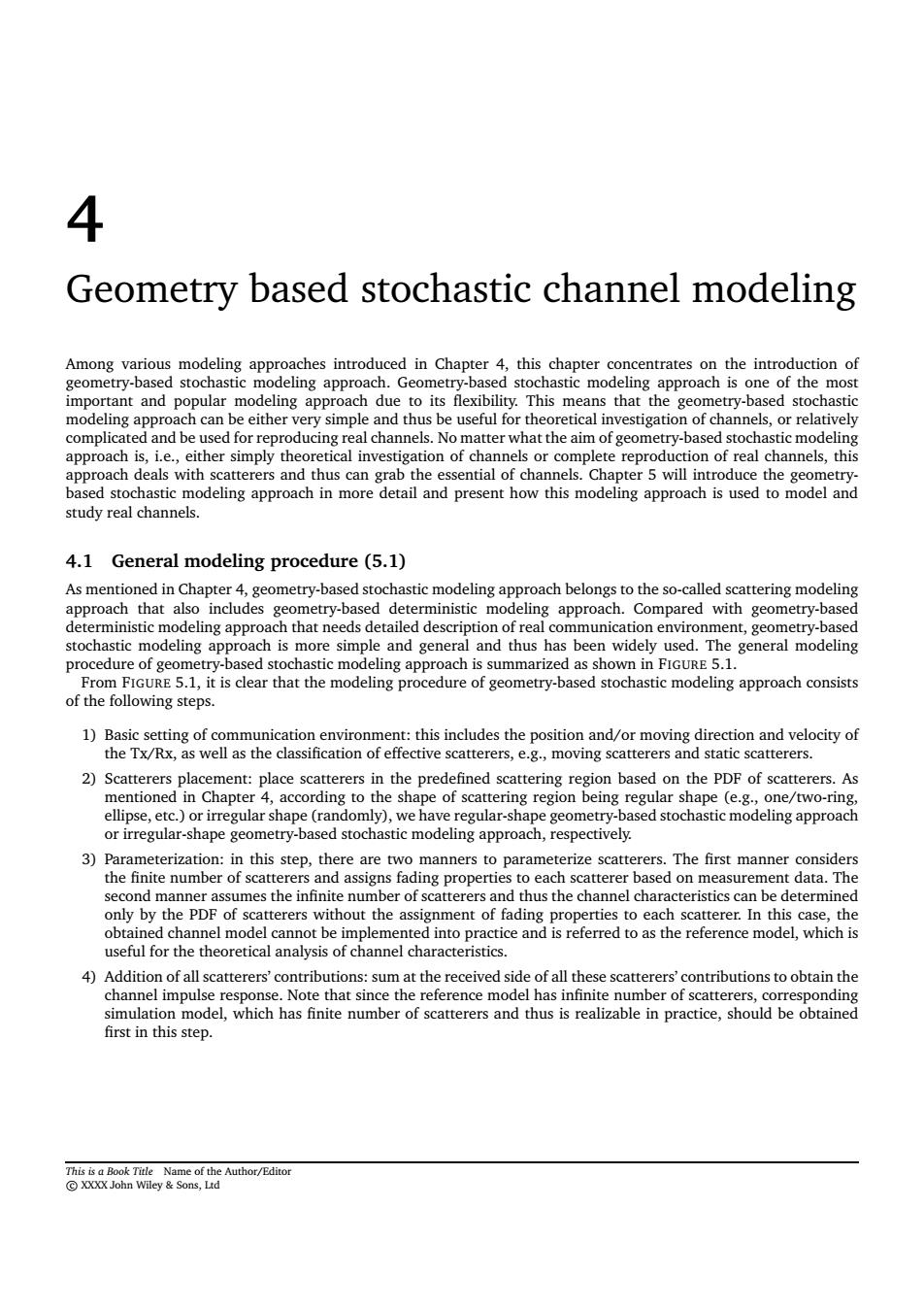正在加载图片...

4 Geometry based stochastic channel modeling Among various modelingroheod Chapterhihpertheo important and popular modeling approach due to its This m eans that the eome -based stochastic approach is,i.e..either simply theoretical investigation of channels or complete reproduction of real channels,this a present how ing approach is used【o study real channels. 4.1 General modeling procedure(5.1) As mentioned in Chapter 4,geometry-based stochastic modeling approach belongs to the so-called scattering modeling stochastis modeng is more simple and general and thus has been widely used.The general modeling of the followin steps. eling approach consists 1)Basic setting of communication environment:this includes the position and/or moving direction and velocity of the Tx/Rx,as well as the classification of effective scatterers,e.g.,moving scatterers and static scatterers. 2)Scatterers placement:place scatterers in the predefined scattering region based on the PDF of scatterers.As mentioned n Chaptera or rresular-shape gcometry-based stochastic modeling approach,respectively ndhi邮s step the finite number of scatt sthe infinite num 一mp nened mo mn5流 er of scatterers d thus the channel characteristics can b de【ermin useful for the theoretical analysis of channel characteristics. 4)Addition of all scatterers'contributions:sum at the received side of all these scatterers'contributions to obtain the first in this step. ,倍4 Geometry based stochastic channel modeling Among various modeling approaches introduced in Chapter 4, this chapter concentrates on the introduction of geometry-based stochastic modeling approach. Geometry-based stochastic modeling approach is one of the most important and popular modeling approach due to its flexibility. This means that the geometry-based stochastic modeling approach can be either very simple and thus be useful for theoretical investigation of channels, or relatively complicated and be used for reproducing real channels. No matter what the aim of geometry-based stochastic modeling approach is, i.e., either simply theoretical investigation of channels or complete reproduction of real channels, this approach deals with scatterers and thus can grab the essential of channels. Chapter 5 will introduce the geometrybased stochastic modeling approach in more detail and present how this modeling approach is used to model and study real channels. 4.1 General modeling procedure (5.1) As mentioned in Chapter 4, geometry-based stochastic modeling approach belongs to the so-called scattering modeling approach that also includes geometry-based deterministic modeling approach. Compared with geometry-based deterministic modeling approach that needs detailed description of real communication environment, geometry-based stochastic modeling approach is more simple and general and thus has been widely used. The general modeling procedure of geometry-based stochastic modeling approach is summarized as shown in FIGURE 5.1. From FIGURE 5.1, it is clear that the modeling procedure of geometry-based stochastic modeling approach consists of the following steps. 1) Basic setting of communication environment: this includes the position and/or moving direction and velocity of the Tx/Rx, as well as the classification of effective scatterers, e.g., moving scatterers and static scatterers. 2) Scatterers placement: place scatterers in the predefined scattering region based on the PDF of scatterers. As mentioned in Chapter 4, according to the shape of scattering region being regular shape (e.g., one/two-ring, ellipse, etc.) or irregular shape (randomly), we have regular-shape geometry-based stochastic modeling approach or irregular-shape geometry-based stochastic modeling approach, respectively. 3) Parameterization: in this step, there are two manners to parameterize scatterers. The first manner considers the finite number of scatterers and assigns fading properties to each scatterer based on measurement data. The second manner assumes the infinite number of scatterers and thus the channel characteristics can be determined only by the PDF of scatterers without the assignment of fading properties to each scatterer. In this case, the obtained channel model cannot be implemented into practice and is referred to as the reference model, which is useful for the theoretical analysis of channel characteristics. 4) Addition of all scatterers’ contributions: sum at the received side of all these scatterers’ contributions to obtain the channel impulse response. Note that since the reference model has infinite number of scatterers, corresponding simulation model, which has finite number of scatterers and thus is realizable in practice, should be obtained first in this step. This is a Book Title Name of the Author/Editor c XXXX John Wiley & Sons, Ltd